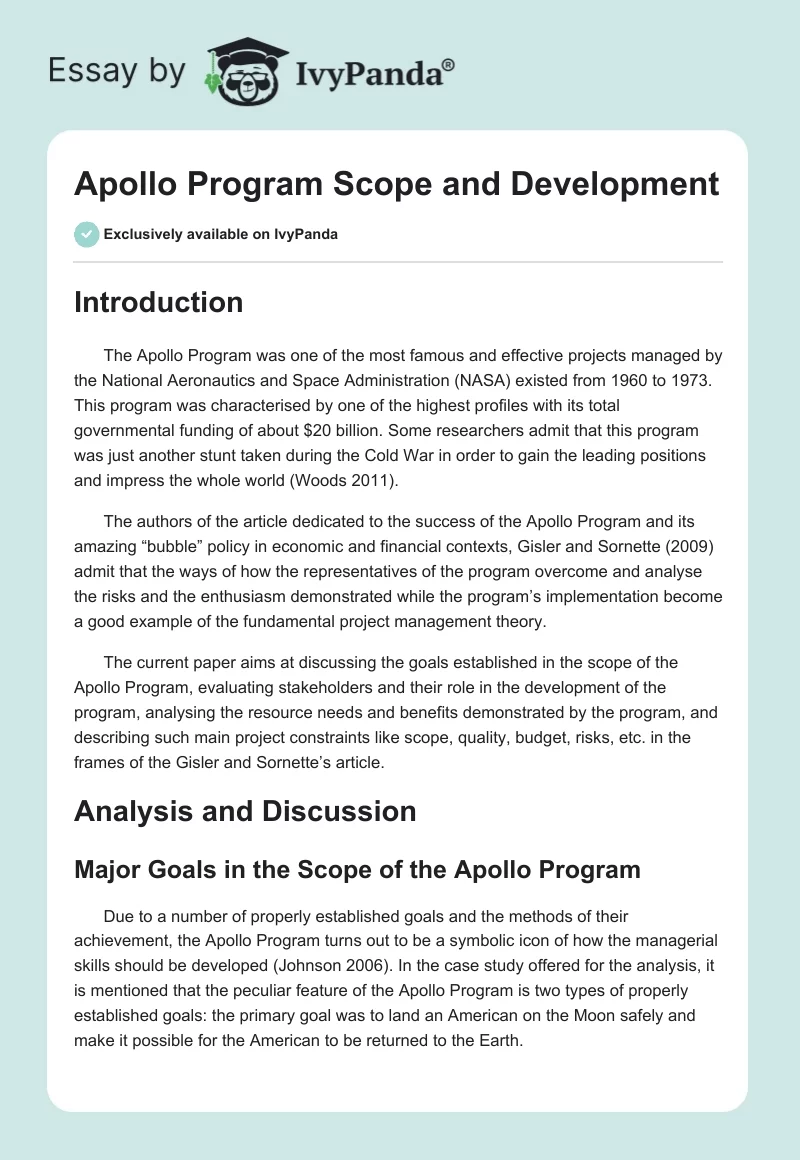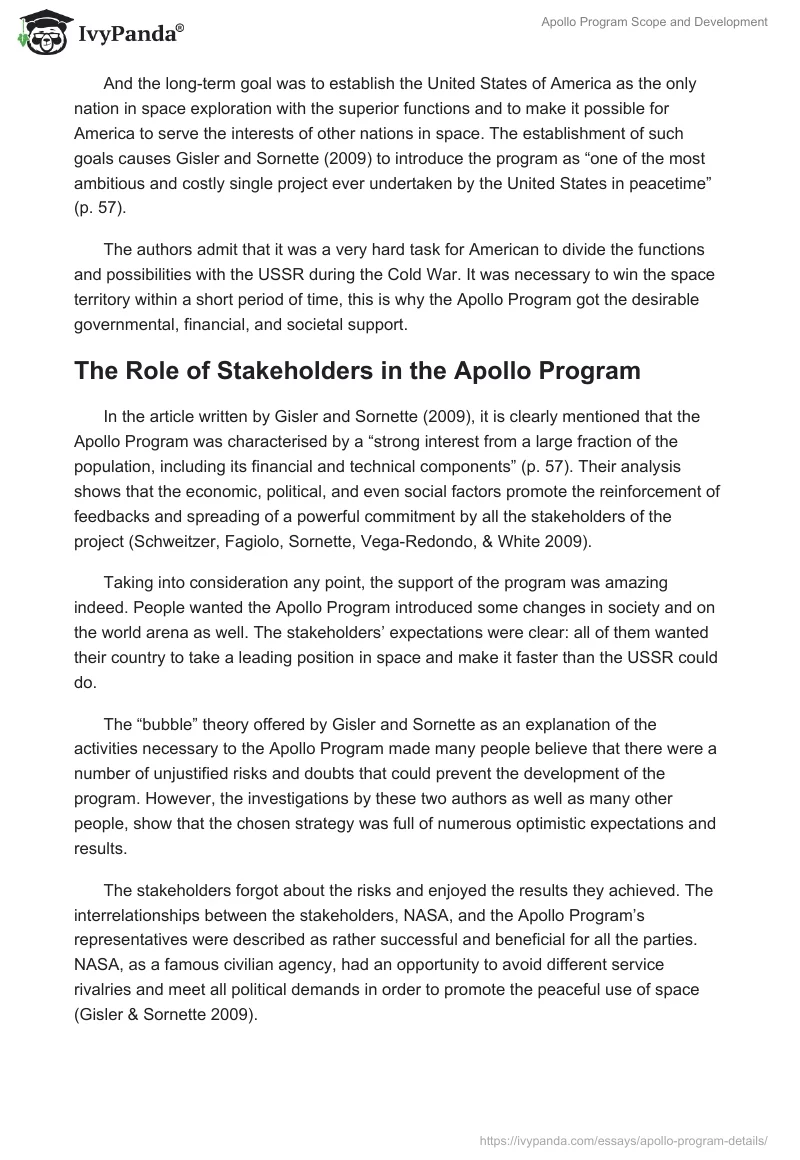Introduction
The Apollo Program was one of the most famous and effective projects managed by the National Aeronautics and Space Administration (NASA) existed from 1960 to 1973. This program was characterised by one of the highest profiles with its total governmental funding of about $20 billion. Some researchers admit that this program was just another stunt taken during the Cold War in order to gain the leading positions and impress the whole world (Woods 2011).
The authors of the article dedicated to the success of the Apollo Program and its amazing “bubble” policy in economic and financial contexts, Gisler and Sornette (2009) admit that the ways of how the representatives of the program overcome and analyse the risks and the enthusiasm demonstrated while the program’s implementation become a good example of the fundamental project management theory.
The current paper aims at discussing the goals established in the scope of the Apollo Program, evaluating stakeholders and their role in the development of the program, analysing the resource needs and benefits demonstrated by the program, and describing such main project constraints like scope, quality, budget, risks, etc. in the frames of the Gisler and Sornette’s article.
Analysis and Discussion
Major Goals in the Scope of the Apollo Program
Due to a number of properly established goals and the methods of their achievement, the Apollo Program turns out to be a symbolic icon of how the managerial skills should be developed (Johnson 2006). In the case study offered for the analysis, it is mentioned that the peculiar feature of the Apollo Program is two types of properly established goals: the primary goal was to land an American on the Moon safely and make it possible for the American to be returned to the Earth.
And the long-term goal was to establish the United States of America as the only nation in space exploration with the superior functions and to make it possible for America to serve the interests of other nations in space. The establishment of such goals causes Gisler and Sornette (2009) to introduce the program as “one of the most ambitious and costly single project ever undertaken by the United States in peacetime” (p. 57).
The authors admit that it was a very hard task for American to divide the functions and possibilities with the USSR during the Cold War. It was necessary to win the space territory within a short period of time, this is why the Apollo Program got the desirable governmental, financial, and societal support.
The Role of Stakeholders in the Apollo Program
In the article written by Gisler and Sornette (2009), it is clearly mentioned that the Apollo Program was characterised by a “strong interest from a large fraction of the population, including its financial and technical components” (p. 57). Their analysis shows that the economic, political, and even social factors promote the reinforcement of feedbacks and spreading of a powerful commitment by all the stakeholders of the project (Schweitzer, Fagiolo, Sornette, Vega-Redondo, & White 2009).
Taking into consideration any point, the support of the program was amazing indeed. People wanted the Apollo Program introduced some changes in society and on the world arena as well. The stakeholders’ expectations were clear: all of them wanted their country to take a leading position in space and make it faster than the USSR could do.
The “bubble” theory offered by Gisler and Sornette as an explanation of the activities necessary to the Apollo Program made many people believe that there were a number of unjustified risks and doubts that could prevent the development of the program. However, the investigations by these two authors as well as many other people, show that the chosen strategy was full of numerous optimistic expectations and results.
The stakeholders forgot about the risks and enjoyed the results they achieved. The interrelationships between the stakeholders, NASA, and the Apollo Program’s representatives were described as rather successful and beneficial for all the parties. NASA, as a famous civilian agency, had an opportunity to avoid different service rivalries and meet all political demands in order to promote the peaceful use of space (Gisler & Sornette 2009).
The Resource Needs and Expected Benefits
The success of any space program depends a lot on the way of how its goals and resource needs are supported. The example demonstrated by the Apollo Program explains how it is necessary to plan and evaluate the worth of each step; its commitment of resources that was about $25 billion in the 1960s. Gisler and Sornette pay a certain attention to the expectations of the society in regards to the implementation of the program.
The point is that almost all expectations were optimistic by their nature, this is why some people just forgot about the level of possible risks and the number of benefits from the returns got (Gisler & Sornette 2009). As a rule, the returns were in the form of social gains and a number of financial profits.
In spite of the fact that the primary and secondary goals were too high (the President declared the necessity to land an American on the Moon within a short period of time) and the resource needs were extremely expensive, the expected benefits proved the necessity to take risks and spend much money on the program.
In addition to the goals set, there were several hidden intentions, such as a chance to win the Cold War and take the leading positions faster than the USSR did. The expected benefits were also connected with a chance to use the solar system and its riches. The USA is the country that does not know the boundaries, this is why it was not enough for NASA to prove the importance of the Apollo Program. It was crucially important to demonstrate the values and an actual scope of the program.
The Actual Benefits and Results of the Program
The Apollo bubble resulted in a variety of changes available for society. The evident and beneficial results are focused on the development of several space programs. Though a several-year break caused certain doubts among the stakeholders, the results demonstrated in 1981and the ability to avoid the spaceflight routine proved that the Apollo Program was worth of recognition: spacewalking, flying through the void, and the Moon became available (Gisler & Sornette 2009).
Project Constraints and Possible Flaws of the Apollo Program
There are six main project constraints that explain the limitation of the project: scope, quality, schedule, budget, resources, and risk (Project Management Institute 2013). The analysis of the processes and the achievements demonstrated by the Apollo Program as the main NASA’s product helps to create the following list of ideas and concepts that introduce a true nature of the program.
Scope: The main goal of the program is to promote landing of an American on the Moon and to establish the power of the USA through space. The project helps the country to win the Cold War and prove its power on a global level.
Quality: The quality of the results requires a perfect combination of the evidence, deadlines, and safety the stakeholders are provided with. The disputes took place between different stakeholders of the program because it touched various aspects like finance, safety, politics, etc.
Schedule: The President could not set the definite deadlines, still, it was stated that the landing had to be achieved within a short period of time and before the attempts made by the USSR.
Budget: The Apollo Program had one of the most expensive budgets for the USA. NASA’s total budget was about $4.2 billion, and the Apollo’s budget was about $3 billion (that was about 70% of the total budget). Still, the economic instability of the 1906s and 1970s promoted considerable changes and losses for NASA. However, the program was not stopped. In general, about 4% of the federal budget were offered for the development of the Apollo Program (Hubbard 2012).
Resources: The financial support on the governmental level helps to choose any kind of resource necessary for the development of the program: special training programs, human resource management, preparations to the flights, etc.
Risks: Because of a high level of enthusiasm demonstrated by all stakeholders, it was difficult to oversee the risks. Still, the situation with Apollo 13 proved that the program was not perfect; even the best materials and readiness of the team could not help to overcome the challenges that take place in space.
The only flaw that was observed in the case study was the inability of NASA to oversee all possible costs and challenges of a space travel and realize a true worth of the intentions the USA had during the Cold War.
Conclusion
In general, the analysis of the Apollo Program and its connection to the society shows how people’s enthusiasm and desire to take a leading position in the world can change the country and make the government provide the organisation with the necessary financial support. The possibility to observe spacewalking and jumps through the void is priceless, and the Apollo Program offers the Americans this opportunity.
Reference List
Gisler, M & Sornette, D 2009, ‘Exuberant innovations: The Apollo program’, Social Science and Public Policy, vol. 46, pp. 55-68.
Hubbard, S 2012, Exploring Mars: Chronicles form a decade of discovery, University of Arizona Press, Tucson.
Johnson, SB 2006, The secret of Apollo: Systems management in American and European space programs, JHU Press, Baltimore Maryland.
Project Management Institute 2013, A guide to the project management body of knowledge, Project Management Insitutte, Newtown Square, Pennsylvania.
Schweitzer, F, Fagiolo, G, Sornette, D, Vega-Redondo, F, & White, D 2009, ‘Economic networks: What do we know and what do we need to know?’, Advances in Complex Systems, vol. 12, no. 4, pp. 407-422.
Woods, WD 2011, How Apollo flew to the moon, Springer Science & Business Media, New York.


